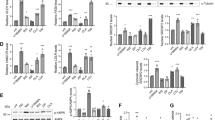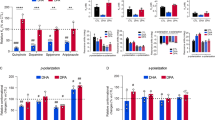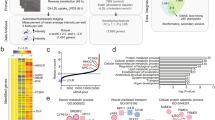Abstract
Antipsychotic drugs (APDs) have been reported to induce lipogenic genes. This has been proposed to contribute to their efficacy in treating schizophrenia and other psychiatric disorders, as well as the metabolic side effects often associated with these drugs. The precise mechanism for the lipogenic effects of APDs is unknown, but is believed to involve increased activation of the lipogenic transcription factors, such as sterol regulatory element binding proteins (SREBPs). In a series of experiments in a model cell line, we found that a panel of typical and atypical APDs inhibited transport of lipoprotein-derived cholesterol to the endoplasmic reticulum (ER), which houses the cholesterol homeostatic machinery. APDs belong to the class of cationic amphiphiles and as has been shown for other amphiphiles, caused lipoprotein-derived cholesterol to accumulate intracellularly, preventing it from being esterified in the ER and suppressing SREBP activation. APDs did not activate the liver X receptor, another transcription factor involved in lipogenesis. However, these drugs markedly reduced cholesterol synthesis. This paradoxical result indicates that the upregulation of SREBP-target genes by APDs may not translate to increased cellular cholesterol levels. In conclusion, we have determined that APDs disrupt intracellular trafficking and synthesis of cholesterol, which may have important clinical ramifications.
This is a preview of subscription content, access via your institution
Access options
Subscribe to this journal
Receive 6 print issues and online access
$259.00 per year
only $43.17 per issue
Buy this article
- Purchase on Springer Link
- Instant access to full article PDF
Prices may be subject to local taxes which are calculated during checkout








Similar content being viewed by others
Abbreviations
- ACC:
-
acetyl-coenzyme A carboxylase
- APDs:
-
antipsychotic drugs
- CHO:
-
Chinese Hamster Ovary
- ER:
-
endoplasmic reticulum
- FAS:
-
fatty acid synthase
- HMG-CoA:
-
3-hydroxy-3-methylglutaryl coenzyme A
- LDL:
-
low-density lipoprotein
- LPDS:
-
lipoprotein-deficient serum
- LXR:
-
liver X receptor
- NPC:
-
Niemann–Pick type C
- NPC1 :
-
Niemann–Pick disease, type C1, gene
- SOAT-1:
-
sterol O-acyltransferase 1
- SREBPs:
-
sterol regulatory element binding proteins
- TLC:
-
thin layer chromatography
References
Aparasu RR, Bhatara V . Patterns and determinants of antipsychotic prescribing in children and adolescents, 2003–2004. Curr Med Res Opin 2007; 23: 49–56.
Jeste DV, Blazer D, Casey D, Meeks T, Salzman C, Schneider L et al. ACNP White Paper: update on use of antipsychotic drugs in elderly persons with dementia. Neuropsychopharmacology 2008; 33: 957–970.
Grunder G, Hippius H, Carlsson A . The ‘atypicality’ of antipsychotics: a concept re-examined and re-defined. Nat Rev Drug Discov 2009; 8: 197–202.
Ferno J, Raeder MB, Vik-Mo AO, Skrede S, Glambek M, Tronstad KJ et al. Antipsychotic drugs activate SREBP-regulated expression of lipid biosynthetic genes in cultured human glioma cells: a novel mechanism of action? Pharmacogenomics J 2005; 5: 298–304.
Polymeropoulos MH, Licamele L, Volpi S, Mack K, Mitkus SN, Carstea ED et al. Common effect of antipsychotics on the biosynthesis and regulation of fatty acids and cholesterol supports a key role of lipid homeostasis in schizophrenia. Schizophr Res 2009; 108: 134–142.
Raeder MB, Ferno J, Vik-Mo AO, Steen VM . SREBP activation by antipsychotic- and antidepressant-drugs in cultured human liver cells: relevance for metabolic side-effects? Mol Cell Biochem 2006; 289: 167–173.
Ferno J, Skrede S, Vik-Mo AO, Havik B, Steen VM . Drug-induced activation of SREBP-controlled lipogenic gene expression in CNS-related cell lines: marked differences between various antipsychotic drugs. BMC Neurosci 2006; 7: 69.
Raeder MB, Ferno J, Glambek M, Stansberg C, Steen VM . Antidepressant drugs activate SREBP and up-regulate cholesterol and fatty acid biosynthesis in human glial cells. Neurosci Lett 2006; 395: 185–190.
Yang LH, Chen TM, Yu ST, Chen YH . Olanzapine induces SREBP-1-related adipogenesis in 3T3-L1 cells. Pharmacol Res 2007; 56: 202–208.
Wiklund ED, Catts VS, Catts SV, Ng TF, Whitaker N, Brown AJ et al. Cytotoxic effects of antipsychotic drugs implicate cholesterol homeostasis as a novel chemotherapeutic target. Int J Cancer 2009; 126: 28–40.
Vik-Mo AO, Birkenaes AB, Ferno J, Jonsdottir H, Andreassen OA, Steen VM . Increased expression of lipid biosynthesis genes in peripheral blood cells of olanzapine-treated patients. Int J Neuropsychopharmacol 2008; 11: 679–684.
Ferno J, Vik-Mo AO, Jassim G, Havik B, Berge K, Skrede S et al. Acute clozapine exposure in vivo induces lipid accumulation and marked sequential changes in the expression of SREBP, PPAR, and LXR target genes in rat liver. Psychopharmacology (Berl) 2009; 203: 73–84.
Goldstein JL, DeBose-Boyd RA, Brown MS . Protein sensors for membrane sterols. Cell 2006; 124: 35–46.
Radhakrishnan A, Goldstein JL, McDonald JG, Brown MS . Switch-like control of SREBP-2 transport triggered by small changes in ER cholesterol: a delicate balance. Cell Metab 2008; 8: 512–521.
Vance JE, Hayashi H, Karten B . Cholesterol homeostasis in neurons and glial cells. Semin Cell Dev Biol 2005; 16: 193–212.
Kristiana I, Yang H, Brown AJ . Different kinetics of cholesterol delivery to components of the cholesterol homeostatic machinery: implications for cholesterol trafficking to the endoplasmic reticulum. Biochim Biophys Acta 2008; 1781: 724–730.
Liscum L, Faust JR . The intracellular transport of low density lipoprotein-derived cholesterol is inhibited in Chinese hamster ovary cells cultured with 3-beta-[2-(diethylamino)ethoxy]androst-5-en-17-one. J Biol Chem 1989; 264: 11796–11806.
Lange Y, Steck TL . Cholesterol homeostasis. Modulation by amphiphiles. J Biol Chem 1994; 269: 29371–29374.
Cenedella RJ . Cholesterol synthesis inhibitor U18666A and the role of sterol metabolism and trafficking in numerous pathophysiological processes. Lipids 2009; 44: 477–487.
Goldstein JL, Rawson RB, Brown MS . Mutant mammalian cells as tools to delineate the sterol regulatory element-binding protein pathway for feedback regulation of lipid synthesis. Arch Biochem Biophys 2002; 397: 139–148.
Wong J, Quinn CM, Brown AJ . Synthesis of the oxysterol, 24(S), 25-epoxycholesterol, parallels cholesterol production and may protect against cellular accumulation of newly-synthesized cholesterol. Lipids Health Dis 2007; 6: 10.
Yang J, Sato R, Goldstein JL, Brown MS . Sterol-resistant transcription in CHO cells caused by gene rearrangement that truncates SREBP-2. Genes Dev 1994; 8: 1910–1919.
Brown AJ, Sun L, Feramisco JD, Brown MS, Goldstein JL . Cholesterol addition to ER membranes alters conformation of SCAP, the SREBP escort protein that regulates cholesterol metabolism. Mol Cell 2002; 10: 237–245.
Brown AJ, Dean RT, Jessup W . Free and esterified oxysterol: formation during copper-oxidation of low density lipoprotein and uptake by macrophages. J Lipid Res 1996; 37: 320–335.
Dahl NK, Reed KL, Daunais MA, Faust JR, Liscum L . Isolation and characterization of Chinese hamster ovary cells defective in the intracellular metabolism of low density lipoprotein-derived cholesterol. J Biol Chem 1992; 267: 4889–4896.
Dahl NK, Daunais MA, Liscum L . A second complementation class of cholesterol transport mutants with a variant Niemann-Pick type C phenotype. J Lipid Res 1994; 35: 1839–1849.
Wojtanik KM, Liscum L . The transport of low density lipoprotein-derived cholesterol to the plasma membrane is defective in NPC1 cells. J Biol Chem 2003; 278: 14850–14856.
Du X, Kristiana I, Wong J, Brown AJ . Involvement of Akt in ER-to-Golgi transport of SCAP/SREBP: a link between a key cell proliferative pathway and membrane synthesis. Mol Biol Cell 2006; 17: 2735–2745.
Vandesompele J, De Preter K, Pattyn F, Poppe B, Van Roy N, De Paepe A et al. Accurate normalization of real-time quantitative RT-PCR data by geometric averaging of multiple internal control genes. Genome Biol 2002; 3: RESEARCH0034.
Horton JD, Goldstein JL, Brown MS . SREBPs: activators of the complete program of cholesterol and fatty acid synthesis in the liver. J Clin Invest 2002; 109: 1125–1131.
Christian AE, Haynes MP, Phillips MC, Rothblat GH . Use of cyclodextrins for manipulating cellular cholesterol content. J Lipid Res 1997; 38: 2264–2272.
Sokol J, Blanchette-Mackie J, Kruth HS, Dwyer NK, Amende LM, Butler JD et al. Type C Niemann-Pick disease. Lysosomal accumulation and defective intracellular mobilization of low density lipoprotein cholesterol. J Biol Chem 1988; 263: 3411–3417.
Roff CF, Goldin E, Comly ME, Cooney A, Brown A, Vanier MT et al. Type C Niemann-Pick disease: use of hydrophobic amines to study defective cholesterol transport. Dev Neurosci 1991; 13: 315–319.
Chang CC, Chen J, Thomas MA, Cheng D, Del Priore VA, Newton RS et al. Regulation and immunolocalization of acyl-coenzyme A: cholesterol acyltransferase in mammalian cells as studied with specific antibodies. J Biol Chem 1995; 270: 29532–29540.
Yang J, Brown MS, Ho YK, Goldstein JL . Three different rearrangements in a single intron truncate sterol regulatory element binding protein-2 and produce sterol-resistant phenotype in three cell lines. Role of introns in protein evolution. J Biol Chem 1995; 270: 12152–12161.
Schultz JR, Tu H, Luk A, Repa JJ, Medina JC, Li L et al. Role of LXRs in control of lipogenesis. Genes Dev 2000; 14: 2831–2838.
Wong J, Quinn CM, Gelissen IC, Brown AJ . Endogenous 24(S),25-epoxycholesterol fine-tunes acute control of cellular cholesterol homeostasis. J Biol Chem 2008; 283: 700–707.
Yang C, McDonald JG, Patel A, Zhang Y, Umetani M, Xu F et al. Sterol intermediates from cholesterol biosynthetic pathway as liver X receptor ligands. J Biol Chem 2006; 281: 27816–27826.
Wong J, Quinn CM, Brown AJ . SREBP-2 positively regulates transcription of the cholesterol efflux gene, ABCA1 by generating oxysterol ligands for LXR. Biochem J 2006; 400: 485–491.
Ory DS . The Niemann-Pick disease genes; regulators of cellular cholesterol homeostasis. Trends Cardiovasc Med 2004; 14: 66–72.
Frolov A, Zielinski SE, Crowley JR, Dudley-Rucker N, Schaffer JE, Ory DS . NPC1 and NPC2 regulate cellular cholesterol homeostasis through generation of low density lipoprotein cholesterol-derived oxysterols. J Biol Chem 2003; 278: 25517–25525.
Silve S, Dupuy PH, Labit-Lebouteiller C, Kaghad M, Chalon P, Rahier A et al. Emopamil-binding protein, a mammalian protein that binds a series of structurally diverse neuroprotective agents, exhibits delta8-delta7 sterol isomerase activity in yeast. J Biol Chem 1996; 271: 22434–22440.
Sanchez-Wandelmer J, Hernandez-Pinto AM, Cano S, Davalos A, de la Pena G, Puebla-Jimenez L et al. Effects of the antipsychotic drug haloperidol on the somastostatinergic system in SH-SY5Y neuroblastoma cells. J Neurochem 2009; 110: 631–640.
Kaddurah-Daouk R, McEvoy J, Baillie RA, Lee D, Yao JK, Doraiswamy PM et al. Metabolomic mapping of atypical antipsychotic effects in schizophrenia. Mol Psychiatry 2007; 12: 934–945.
Xiao L, Xu H, Zhang Y, Wei Z, He J, Jiang W et al. Quetiapine facilitates oligodendrocyte development and prevents mice from myelin breakdown and behavioral changes. Mol Psychiatry 2008; 13: 697–708.
Le Hellard S, Theisen FM, Haberhausen M, Raeder MB, Ferno J, Gebhardt S et al. Association between the insulin-induced gene 2 (INSIG2) and weight gain in a German sample of antipsychotic-treated schizophrenic patients: perturbation of SREBP-controlled lipogenesis in drug-related metabolic adverse effects? Mol Psychiatry 2009; 14: 308–317.
Dietschy JM, Turley SD . Thematic review series: brain Lipids. Cholesterol metabolism in the central nervous system during early development and in the mature animal. J Lipid Res 2004; 45: 1375–1397.
Lange Y, Ye J, Rigney M, Steck T . Cholesterol movement in Niemann-Pick type C cells and in cells treated with amphiphiles. J Biol Chem 2000; 275: 17468–17475.
Lusa S, Heino S, Ikonen E . Differential mobilization of newly synthesized cholesterol and biosynthetic sterol precursors from cells. J Biol Chem 2003; 278: 19844–19851.
Radhakrishnan A, Sun LP, Kwon HJ, Brown MS, Goldstein JL . Direct binding of cholesterol to the purified membrane region of SCAP: mechanism for a sterol-sensing domain. Mol Cell 2004; 15: 259–268.
Radhakrishnan A, Ikeda Y, Kwon HJ, Brown MS, Goldstein JL . Sterol-regulated transport of SREBPs from endoplasmic reticulum to Golgi: oxysterols block transport by binding to Insig. Proc Natl Acad Sci USA 2007; 104: 6511–6518.
Chen JK, Taipale J, Cooper MK, Beachy PA . Inhibition of Hedgehog signaling by direct binding of cyclopamine to Smoothened. Genes Dev 2002; 16: 2743–2748.
Adams CM, Goldstein JL, Brown MS . Cholesterol-induced conformational change in SCAP enhanced by Insig proteins and mimicked by cationic amphiphiles. Proc Natl Acad Sci USA 2003; 100: 10647–10652.
Cenedella RJ, Sexton PS, Krishnan K, Covey DF . Comparison of effects of U18666A and enantiomeric U18666A on sterol synthesis and induction of apoptosis. Lipids 2005; 40: 635–640.
Gale SE, Westover EJ, Dudley N, Krishnan K, Merlin S, Scherrer DE et al. Side chain oxygenated cholesterol regulates cellular cholesterol homeostasis through direct sterol-membrane interactions. J Biol Chem 2009; 284: 1755–1764.
Acknowledgements
The Brown Lab is supported by grants from the Prostate Cancer Foundation of Australia (PR36) and the National Health and Medical Research Council (568619). We thank the members of the Brown Lab for providing critical feedback.
Author information
Authors and Affiliations
Corresponding author
Ethics declarations
Competing interests
The authors declare no conflict of interest.
Additional information
Supplementary Information accompanies the paper on the The Pharmacogenomics Journal website
Supplementary information
Rights and permissions
About this article
Cite this article
Kristiana, I., Sharpe, L., Catts, V. et al. Antipsychotic drugs upregulate lipogenic gene expression by disrupting intracellular trafficking of lipoprotein-derived cholesterol. Pharmacogenomics J 10, 396–407 (2010). https://doi.org/10.1038/tpj.2009.62
Received:
Revised:
Accepted:
Published:
Issue Date:
DOI: https://doi.org/10.1038/tpj.2009.62
Keywords
This article is cited by
-
Activation of the PERK-CHOP signaling pathway during endoplasmic reticulum stress contributes to olanzapine-induced dyslipidemia
Acta Pharmacologica Sinica (2024)
-
Olanzapine, risperidone and ziprasidone differently affect lysosomal function and autophagy, reflecting their different metabolic risk in patients
Translational Psychiatry (2024)
-
Deciphering molecular mechanisms underlying chemoresistance in relapsed AML patients: towards precision medicine overcoming drug resistance
Cancer Cell International (2021)
-
New Avenues for Treatment and Prevention of Drug-Induced Steatosis and Steatohepatitis: Much More Than Antioxidants
Advances in Therapy (2021)
-
Key role for lipids in cognitive symptoms of schizophrenia
Translational Psychiatry (2020)



